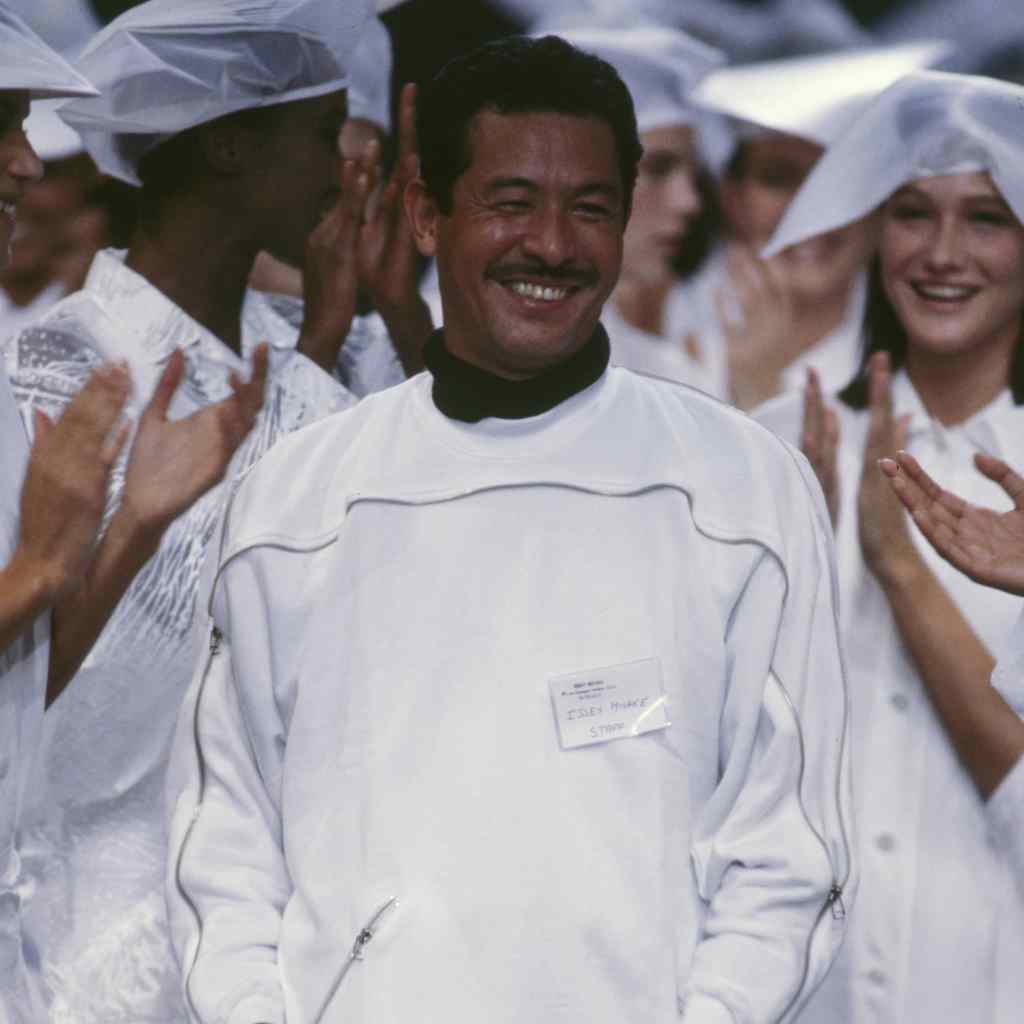As the world continues to mourn the passing of fashion luminary Issey Miyake, one thing is certain: he leaves behind an immeasurable design legacy. Throughout the scope of his prolific career, he revolutionised fabrication, introduced Japanese avant-garde style to the west, championed diversity on and off the runway, embraced colour theory alongside minimalism, and pushed the bounds of “art as fashion.”
Few designers are responsible for disrupting the industry and rewriting the design cannon in such an impactful way as Miyake. With a background in graphic design, and trained in Paris under top couturiers Laroche and Givenchy, as well as Geoffrey Beene, Miyake’s unique education informed much of his work.
It’s no wonder his design language captivated everyone, from the Olsen twins and Solange to Kim Kardashian and Rihanna. The late design maverick created with intention and always with a distinct point of view, which made Issey Miyake clothing so enticing. To own a Miyake piece is to own a piece of moving sculpture.
So many timeless design codes cement Miyake and his work into the culture. There’s Issey Mikaye’s bag, the Bao Bao, that is a cult favorite of the art crowd and street-style set, as seen on the likes of OG blogger Susie Lau. And who could forget Steve Job’s infamous sleek black turtleneck, which was exclusively designed by Miyake? Yet another timeless Miyake signature is the striking, minimal product design of his namesake perfume bottles. Miyake was always on the pulse, always in touch with the zeitgeist even when he was years ahead of it.
From the signature pleated fabrication house code to his lifelong friendship and working-muse relationship with fashion icon Grace Jones, let’s look back at six vital design elements and moments of the architectural designer ahead.
Related: Iconic Fashion Designer Issey Miyake Has Died at Age 84
Getty / Taylor Hill
Issey Miyake Pleats
One of the most recognizable Issey Miyake house codes today is the pleated fabrication. In the late ’80s, he began experimenting with new methods of pleating, and in 1993, the Pleats Please line was launched, showing officially during the Spring/Summer 1994 season.
Here, a masterfully-crafted 1994 Issey Miyake “Flying Saucer” dress on display at the press preview for the Costume Institute’s annual exhibition “About Time: Fashion and Duration.”
Daniel Zuchnik / Getty
Issey Miyake Pleats Please
Today, the Pleats Please line is alive and well, with the addition of a mens fusion line, HOMME PLISSÉ, in 2013.
Getty / Edward Berthelot
Issey Miyake Bag
Issey Miyake’s signature bag, named “The Bao Bao,” is another example of the house’s innovative design concepts and masterful techniques. The architectural, multidimensional handbag debuted in 2000, and launched as a separate line in 2010.
Getty / Edward Berthelot
Issey Miyake Bag
Named after the Bilbao as a nod to the Frank-Gehry-designed Guggenheim Museum, the bag remains a timeless street-style staple today.
Getty / Daniel SIMON
Breastplates
Known for his advanced fabric techniques, Miyake expanded on the notion of body moulding, developing a series of metallic breastplates. These were made of molded fiber-reinforced plastic, as shown here in an image from Miyake’s runway show in Fall/Winter 1985/86.
David Corio / Redferns
Breastplates
Several of those Miyake breastplates were famously worn by fashion icon and muse Grace Jones.
Getty / Gregory Pace
Grace Jones As a Muse
Speaking of Jones, the music legend is one of the biggest collectors of Miyake. Her expansive collection is evidence of the beautiful working relationship and friendship between the two creatives. From modeling in his earlier shows, to wearing his creations on stage and in music videos, she organically personified the essence of the Miyake woman.
Getty / AFP
Movement
Initially wanting to pursue dance, Issey Miyake was always inspired by the art of movement and the way fabric swayed with the wearer. This love for dance and movement was a consistent theme throughout all his work.
Getty / PIERRE VERDY
Movement
Miyake even made custom pieces for William Forsythe’s Frankfurt Ballet Company in 1991, which later, through research and development, led to the creation of Pleats Please a few years later.
Getty / Victor VIRGILE
Diversity Before It Was a Thing
Issey championed diversity on the runway and editorially, long before it was a trend or an industry standard – from dressing Iman and Grace Jones to casting models of color at every opportunity.
Getty / Victor VIRGILE
Diversity Before It Was a Thing
He placed Black models front and center in the ’80s and ’90s, following his revolutionary 1976 runway show “Issey Miyake and Twelve Black Girls,” which featured Grace Jones.
Pierre Verdy / AFP via Getty Images
One Piece of Fabric
Through his A–POC (A Piece of Clothing) fabrication work, he developed the concept of self–tailored clothing. It’s a concept based on a single, industrially-produced, tube-like piece of fabric that the wearer can cut to create a custom outfit, which also speaks to the issue of sustainability. For his Spring/Summer 1999 collection, he showcased models attached to each other through a thread of red fabric.
Getty / Xinhua News Agency
One Piece of Fabric
This eventually became a design code of the house, as demonstrated here at his Fall 2020 show.
See more photos of Issey Miyake and his iconic designs below.

